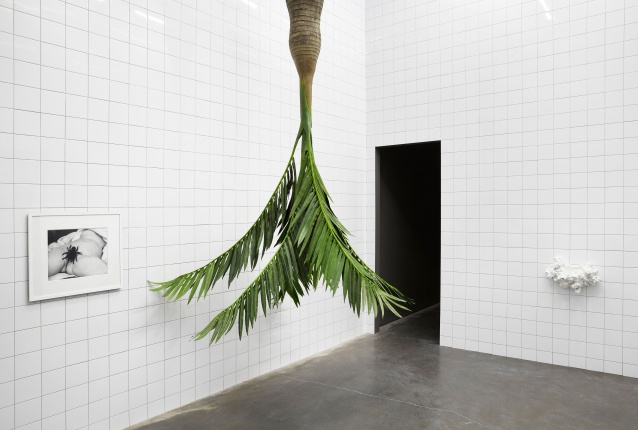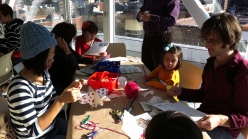“Rosemarie Trockel: A Cosmos” presents an imaginary universe in which Trockel’s own artwork from the past thirty years is juxtaposed with objects and artifacts from different eras and cultures that map many of her artistic interests.
“Rosemarie Trockel: A Cosmos,” 2012–13. Exhibition view: New Museum. Photo: Benoit Pailley
Second Floor, Third Floor, and Fourth Floor Visit Us
Although remarkably inventive and prolific, Trockel has deflected any identifiable stylistic signature: films and videos, knit paintings, projects for children, ceramics, drawings, and collages, plus a panoply of sculptures in a range of materials, are among the myriad forms that comprise her practice. Nonetheless, certain constants underpin this diverse activity: contending notions of feminism, purported antagonisms between the amateur and professional creator, the celebrity and the unknown maker, and between the fine, as opposed to the applied, arts and crafts. More broadly, Trockel probes interrelations between humans and animals, and our impact, as a species, on the natural world.
The epicenter of “Rosemarie Trockel: A Cosmos” is a small, tiled room devoted exclusively to the work of this mid-career German artist; reminiscent of a Wunderkammer, it mixes the fantastical, the erotic, and the perverse. The exhibition spaces that radiate from this nucleus throughout the Museum’s three floors have been installed typologically, as in a traditional natural history museum, or thematically, as in many museums of modern art. These very distinct installation strategies generate fundamentally different ways of viewing.
 “Rosemarie Trockel: A Cosmos,” 2012–13. Exhibition view: New Museum. Photo: Benoit Pailley
“Rosemarie Trockel: A Cosmos,” 2012–13. Exhibition view: New Museum. Photo: Benoit Pailley
Trockel’s work in ceramic is the focal point on the Fourth Floor, pairing sculptures that engage issues of reproduction and replication with forms more organic and rudimentary. The Third Floor is devoted to Trockel’s works made with wool, often considered her signature material.
The Museum’s Second Floor presents a broad selection of Trockel’s work in conjunction with a selection of artifacts created by individuals not normally recognized as professional artists, whom she considers kindred spirits, nonetheless. Many come from the realm of natural history, and from zoology and botany, in particular. The drawings and models they created originally served as pedagogical tools for scientific research but today are appreciated primarily in aesthetic terms. In addition, there are a number of self-taught artists, including James Castle, Morton Bartlett, Judith Scott, and Manuel Montalvo, who worked in isolation or obscurity—the products of their fertile imaginations created with the humblest of materials and the most economic of means. Also present are works by two contemporary artists whose reputations have unjustifiably gone into eclipse, Günter Weseler and Ruth Francken, as well as an abstract expressionist triptych made by an orangutan, Tilda, appropriated and arranged by Trockel. Whether operating within the framework of a disciplinary field, like botany, or propelled by more autonomous internal directives, these highly diverse figures provide models of dedication to their chosen vocations that, for Trockel, are exemplary and inspiring.
The imaginary world limned in “A Cosmos” is intended to be neither definitive nor exhaustive. Just as the terrain it charts remains open to new discoveries, individual works may be considered as representative of fields of knowledge and experience that together elucidate Trockel’s multifaceted practice in fresh and unprecedented ways.
“Rosemarie Trockel: A Cosmos” has been curated by Lynne Cooke, former Deputy Director and Chief Curator, Museo Centro de Arte Reina Sofía, in collaboration with Rosemarie Trockel. The New Museum’s presentation has been organized in conjunction with the artist and curator by Massimiliano Gioni, Associate Director and Director of Exhibitions, and Jenny Moore, Associate Curator.
After its presentation at the New Museum, the exhibition will travel to the Serpentine Gallery, London. The exhibition was first on view at Museo Nacional Centro de Arte Reina Sofía from May 23–September 24, 2012.
























